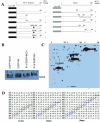DAXX interacts with phage PhiC31 integrase and inhibits recombination
- PMID: 17098929
- PMCID: PMC1669754
- DOI: 10.1093/nar/gkl890
DAXX interacts with phage PhiC31 integrase and inhibits recombination
Abstract
Phage PhiC31 integrase has potential as a means of inserting therapeutic genes into specific sites in the human genome. However, the possible interactions between PhiC31 integrase and cellular proteins have never been investigated. Using pLexA-PhiC31 integrase as bait, we screened a pB42AD-human fetal brain cDNA library for potential interacting cellular proteins. Among 61 positives isolated from 10(6) independent clones, 51 contained DAXX C-terminal fragments. The strong interaction between DAXX and PhiC31 was further confirmed by co-immunoprecipitation. Deletion analysis revealed that the fas-binding domain of DAXX is also the region for PhiC31 binding. Hybridization between a PhiC31 integrase peptide array and an HEK293 cell extract revealed that a tetramer, 451RFGK454, in the C-terminus of PhiC31 is responsible for the interaction with DAXX. This tetramer is also necessary for PhiC31 integrase activity as removal of this tetramer resulted in a complete loss of integrase activity. Co-expression of DAXX with PhiC31 integrase in a HEK293-derived PhiC31 integrase activity reporter cell line significantly reduced the PhiC31-mediated recombination rate. Knocking down DAXX with a DAXX-specific duplex RNA resulted in increased recombination efficiency. Therefore, endogenous DAXX may interact with PhiC31 causing a mild inhibition in the integration efficiency. This is the first time that PhiC31 was shown to interact with an important cellular protein and the potential effect of this interaction should be further studied.
Figures



References
-
- Hacein-Bey-Abina S., von Kalle C., Schmidt M., Le Deist F., Wulffraat N., McIntyre E., Radford I., Villeval JL., Fraser C.C., Cavazzana-Calvo M., et al. A serious adverse event after successful gene therapy for X-linked severe combined immunodeficiency. N. Engl. J. Med. 2003;348:255–256. - PubMed
-
- Vega M.A. Prospects for homologous recombination in human gene therapy. Hum. Genet. 1991;87:245–253. - PubMed
-
- Smith M.C., Thorpe H.M. Diversity in the serine recombinases. Mol. Microbiol. 2002;44:299–307. - PubMed
-
- Sauer B., Henderson N. Targeted insertion of exogenous DNA into the eukaryotic genome by the Cre recombinase. New Biol. 1990;2:441–449. - PubMed
Publication types
MeSH terms
Substances
LinkOut - more resources
Full Text Sources
Other Literature Sources
Research Materials
Miscellaneous

